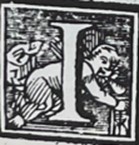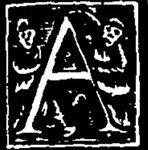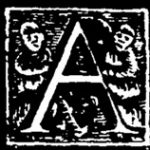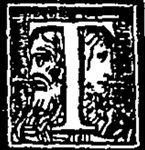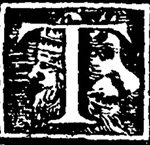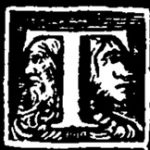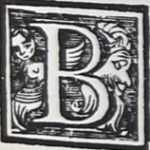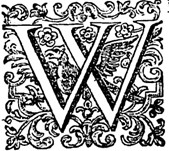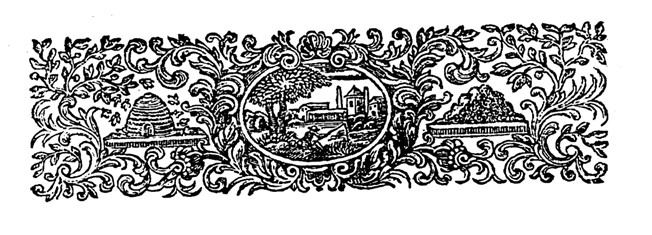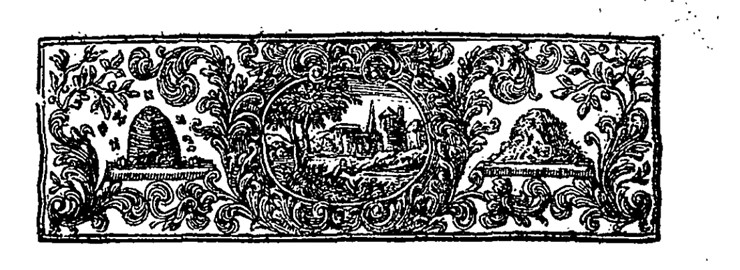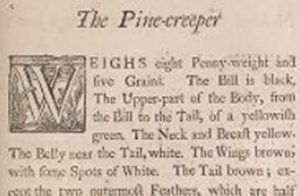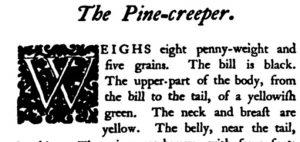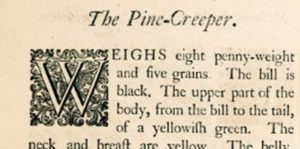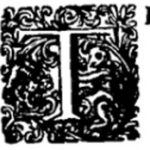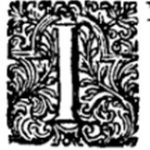Table of contents
- Introduction
- Printers
- Methods & Materials
- Case Studies
- Visualisations
- Reflection
- Conclusion
- Division of Labour and Reflection on Learning
- References
Case study 1: Bowyer and Dublin
Maslen’s book on Bowyer’s work (1973, pp. 38-39) presents two decorative initials that were also found in our final set of clusters. All the other Bowyer DIs that we are going to talk about after these following two did not initially appear in our clusters. One of the DIs we named “Bowyer_A_two_people_facing_to_their_right” and the other “Bowyer_I_crawling_baby”.
Looking into the former’s cluster bore interesting results. There were leads for further research in the form of a book about gardening (abbreviated: New improvements of planting and gardening, both philosophical and practical: Explaining the Motion of the Sap and Generation of Plants) which was originally published in London and then reprinted in Dublin by George Grierson. It had a big collection of Bowyer’s decorated initials, some of which did not appear in the clusters that form our dataset as we hinted just before. So, this brought to our attention that there were some DIs missing in our clusters (covered in more detail under “Reflection”, subsection “Missing DIs”). But more importantly, it could be seen that the DIs in the Dublin reprint often differed slightly from Bowyer’s original DIs. When it comes to the DI “Bowyer_A_two_people_facing_to_their_right”, the Dublin version has the same decorated initial which looks almost identical, but the people are not facing to their right. Rather they are facing forward to gaze at the reader. The visual search tool of the Compositor revealed that this version of people facing straight forward appears only in books printed in Dublin, whilst the version of the people facing to their right is characteristic to books printed in London.
This was not the only decorated initial from that book bearing this peculiar trend. There was also the original Bowyer’s initial “Bowyer_the_man_and_woman” which was used as a reference for the Dublin versions of the DIs “the_king_and_giant” and “the_old_and_young_man”. As with the previous slightly differing DI pairing, the original “Bowyer_the_man_and_woman” appears only in the London prints, and the two slightly differing DIs appear in Dublin prints, whose publisher is marked in the database in nearly all cases as George Grierson.
These findings were not limited to the gardening book mentioned before, as a few other books also used those initials that were very similar to Bowyer’s but bore some differences. For example: Poems on several occasions: by Matthew Prior Esq., The spectator, A journey to Mequinez; the residence of the present Emperor of Fez and Morocco and Short remarks on the coins current in this kingdom. The association between the books is again the fact that they were printed in Dublin. All but the last two have the information that they were also printed by George Grierson. The last book’s printer is unknown and the book about the Emperor of Fez and Morocco has only the information that the book was printed for George Ewing. Furthermore, The spectator has another DI that looks almost the same as one of Bowyer’s DIs but is not the same as the original:
Aside from the Dublin books, which are known to be printed by Grierson, the slightly different DIs do not occur in the data. Therefore, it might be reasonable to assume that the outlier books, one which does not have information about the printer, and the other that was printed for George Ewing, were also printed by George Grierson. It is known that London and Dublin publishers and printers made agreements with each other to ensure a smoother market situation, thus Bowyer also had business connections in Dublin, e.g. with George Faulkner (Rounce, 2013, pp. 203, 205). Additionally, Oliver Nelson apprenticed to Grierson and possibly worked for Bowyer prior to that (Hourican, n.d.), which implies that there could have been connections between the London and Dublin printer that helped Nelson move from one place to another through the familiarity of Bowyer and Grierson. We could not find any papers that directly connected Grierson to Bowyer, but we found various book printing and DI connections between them in our project’s data, so there could have been relevant relations between them that are currently not widely known. It is hard to track the publishing networks of the 18th century as there are not many easily available sources about the topic. Using decorations in the books as demonstrated here and adding more in-depth qualitative research to the process could be a way to uncover the lost networks.
Case study 2: Richardson and the case of the Two similar DIs
Upon finding a pair of DIs with remarkable similarity, that were paired with headpieces of equal similarity we were led onto a trail of possible Richardson books, that were connected by the sets of initials used between multiple titles in our database. The initial “Richardson_W_Bird_without_Angelhead” was used in books rich with DIs, such as The Adventurer, The Devil, Survey of the Cities of London and Westminster and The natural history of Carolina, Florida, and the Bahama Islands. It was identified to be one of Richardson’s from the book on his print work by Maslen (2001). His style is fairly distinct, containing airy, wavy florals combined with a central figure and some geometrical raised lines. We researched the second DI which we named “W_Bird_with_Angelhead_Original”, in hopes of finding an explanation for the similarity of the DI and HP pairing, but efforts fell short. Instead the second variant was found to have a Bowyer connection. While researching these two DI variants, it was discovered that many of the DIs in these books were not included in the final clusters annotated by us (see “Missing DIs” under “Reflection“) and further work had to be conducted using the master file that contains all the DIs. The relationship of the Original and Richardson variants remains a mystery. What brought about the unlikely pairing of these near identical DIs with the near identical headpieces is still unknown to us, but a lot of ground has been covered on their use.
The following chapter gives an account of the “Richardson” variant, and it is followed by a shorter chapter on the “Original” variant of the DI.
Case study 3: Samuel Richardson & The Natural History of Carolina, Florida, and the Bahama Islands
This part of the blog describes an example case study of a specific decorative initial (DI) and our endeavour to connect it to a bigger picture of the 18th century London’s book publishing world.
We first looked at the ornaments used by publisher Samuel Richardson, and tried to find the same decorative initials in our own ECCO dataset. We got one hit, the DI Keith Maslen (2001) labelled as “R507”, seen below. During our annotation process we named the DI “Richardson_W_Bird_without_Angelhead” in our ECCO dataset. Even though this DI appeared only 18 times in our dataset, the connection to Richardson’s ornaments made it interesting and relevant to study. 11 occurrences of this DI were in a 1754 book by Mark Catesby, volume I of The natural history of Carolina, Florida, and the Bahama Islands.
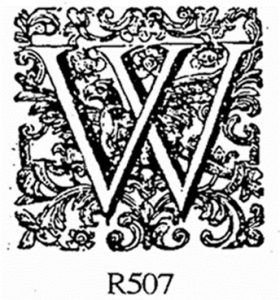

The Natural History of Carolina, Florida, and the Bahama Islands is a book by naturalist Mark Catesby (1683–1749). It depicts the flora and fauna he encountered in his seven-year trip to North America (Royal Collection Trust, n.d.). The book’s first edition was published in 11 parts between 1729 and 1747 (Nelson, 2015). The first edition contained colourful pictures created by Catesby himself: he transferred his original sketches to copper plates, and after the images were printed, he coloured each image by hand. For the printing of both the text and images he engaged Godfrey Smith of Spitalfields (Nelson, 2022).
A second edition of The Natural History of Carolina, Florida, and the Bahama Islands was produced five years after Catesby’s death by naturalist and friend of Catesby, George Edwards, in 1754. This edition is said to be identical to the first, and the images were printed using the same copper plates made by Catesby (Costantino, 2018). The second edition was published by Charles Marsh, Thomas Wilcox, and Benjamin Stichall. Edwards was close to Catesby and his family, and he most likely acted as an intermediary when Catesby’s widow sold the original drawings to Marsh, Wilcox and Stichall (Royal Collection Trust, n.d.). This explains how they ended up publishing the second edition of The Natural History of Carolina, Florida, and the Bahama Islands. This is the edition in our ECCO dataset.

In 1771, a third edition of the book was published by bookseller Benjamin White. This edition also used the original copper plates by Catesby, but it is made up of completely reset text with later additions (Costantino, 2018).
All of these editions can be found online in The Biodiversity Heritage Library’s collections and we used these as source material for our analysis: the first edition can be found here, the second edition here and the third edition here. Even though we already had the second edition of the book in our ECCO dataset, the quality of the OCR’d pages was sometimes poor and it proved to be beneficial to have another version to work with.
Each of the three editions of The Natural History of Carolina, Florida, and the Bahama Islands have different publishers. The first edition was published by Catesby himself, the second by Charles Marsh, Thomas Wilcox, and Benjamin Stichall. The third edition was published by Benjamin White. What is interesting concerning this project is the difference in the decorative initials used in the editions. The second (1754) and third editions (1771) have almost the same DIs in cases where the contents are the same, but the first edition (1729–1747), published by the author himself, has unique DIs. The second edition (1754) is the one we have in our dataset and where “Richardson_W_Bird_without_Angelhead” is found for the first time. Below are the examples of the DI from page 61 in each of the book’s three editions.
Between the first and second edition of the book Samuel Richardson’s DI “R507” came into use. However, there is no mention of Richardson involvement with the printing or publishing of the editions of The Natural History of Carolina, Florida, and the Bahama Islands. According to Maslen (2001), “R507” has been used twice in Richardson’s work, first in 1742 in a Parliamentary context, and again in 1755 in a descriptive poem. The publication of the second edition of The Natural History of Carolina, Florida, and the Bahama Islands in 1754 fits nicely between these two occurrences.
The next step was to try to find a connection between Richardson and the publishers of the second edition Charles Marsh, Thomas Wilcox, and Benjamin Stichall. All of them were active roughly during the same time period according to British Book Trade Index (BBTI) that lists “brief biographical and trade details of all those who worked in the English and Welsh book trades up to 1851”. Charles Marsh was said to be a bookseller, a publisher, and an author. Thomas Wilcox worked as a bookseller, a librarian, and an owner of a circulating library. Benjamin Stichall was a bookbinder and a bookseller. All of them worked along or close to the Strand, and Richardson is known to have resided and worked in the Salisbury Court area nearby (Maslen, 2001). These places have been marked on the map below with turquoise dots.
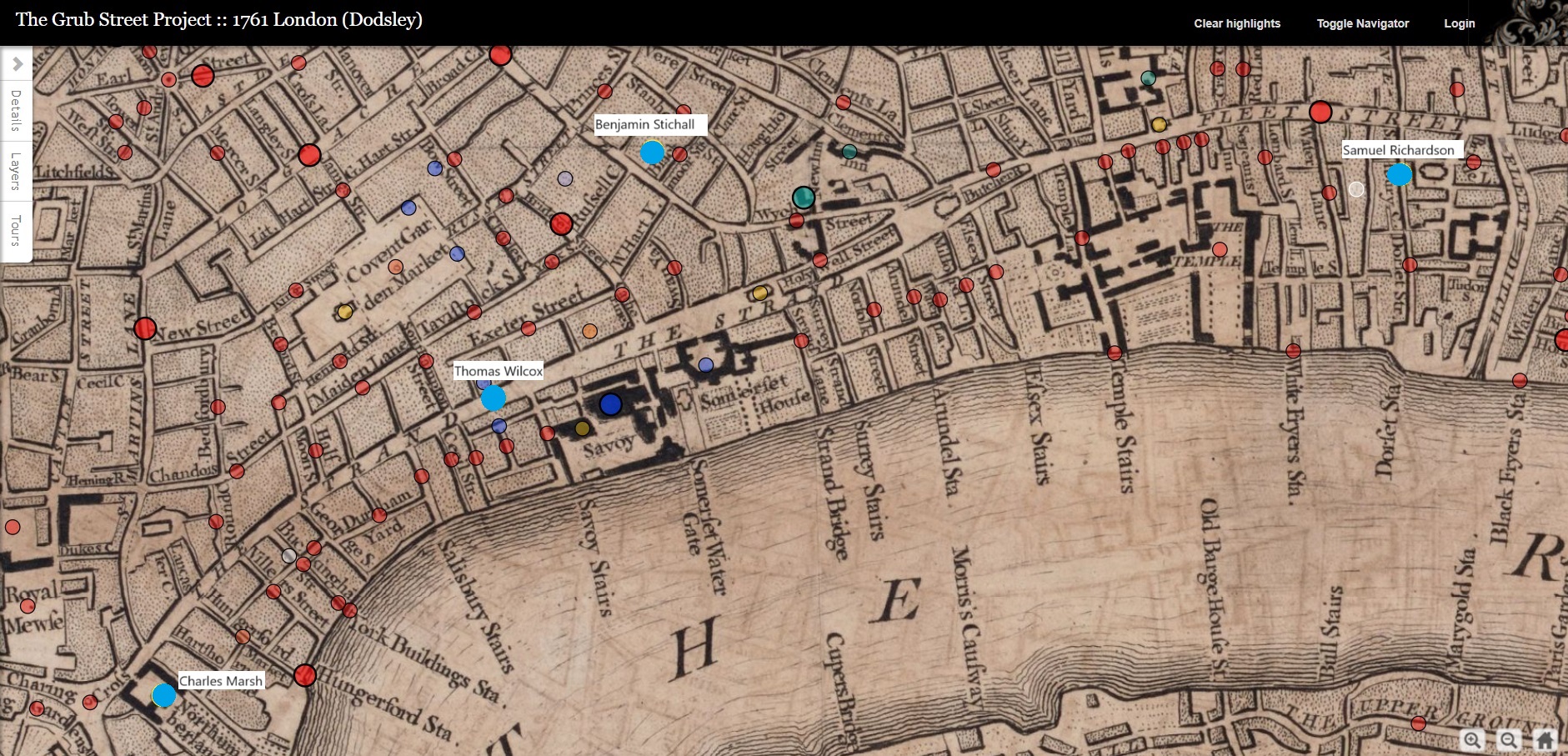
We tried to find secondary literature about Samuel Richardson and his connections in the 18th century London book printing scene, but most of the literature that could have been helpful for us required paid access. This made it impossible for us to find a clear connection between Samuel Richardson and the publishers of the second edition of The Natural History of Carolina, Florida, and the Bahama Islands. However, considering the importance of Richardson in the London printing scene, these characters are likely to have been in contact with each other. Also, as Maslen has identified “R507” as Richardson’s ornament we feel that there has to be some connection between the publishers, although the specifics will remain hidden for now. Of course there is a possibility that Maslen is incorrect and the ornament is actually not Richardson’s or it was used by many printers.
Case study 4: The “Original” Variant and a Bowyer Connection
In order to explain the similarities between the two DIs, “Richardson_W_Bird_without_Angelhead” and “W_Bird_with_Angelhead_Original”, all titles using the latter DI in our clusters were examined to find patterns of DI sets used in them. This was achieved using the filtering function in our cluster file to filter by book titles represented in the cluster. These titles were then searched separately in the master DI file by typing the title name in the search tool and clicking open each image available on file for that title, in one case all 115 images. The only printer mentioned in the W_Bird_with_Angelhead_Original cluster was T. Wood, and his other titles in our database were also searched and inspected. Based on the use of the same sets of decorative initials, The laws of the British plantations in America (1721) was also printed by Wood. Upon filtering our clusters for other books printed by T. Wood and inspecting the DIs in the master file for C. Julius Cæsar’s Commentaries of his wars in Gaul (1732) printed by him, the book was found to contain verified Bowyer initials.
For The laws of the British plantations in America (1721), the master DI file contains 18 entries, one of which bears resemblance to Bowyers potted plant DIs (Maslen, 1973). This book is published by B. Cowse, and its printer is not named. The history of the reformation and other ecclesiastical transactions (1720) has 115 DI entries in the master file. It is Published by Timothy Childe and printed by T. Wood. Many of the initials are the same as used in The laws of the British plantations in America. Aside from a few elaborate exceptions, the initials are not paired with headpieces here. A supplement to Rapin’s History of England (1741) is the last book using this initial in our cluster. The book only has 10 DIs in the master csv file, and many of them do not appear in the previous books. However, similar or same elaborate headpieces are used as in The history of the reformation and other ecclesiastical transactions. The publisher is T. Cox and no printer is mentioned. All these titles were discovered from our clusters because they use the DI W_Bird_with_Angelhead_Original. It is possible that more titles that are not present in our clusters use this DI. More importantly, as these books contain repeating sets of DIs, those DIs could be further looked into to uncover potential books that use the same sets of initials excluding the “W_Bird_with_Angelhead_Original”.
As we know the printer T. Wood, it was also possible to look for his other titles in our cluster. From the six titles available, I only looked into one, C. Julius Cæsar’s Commentaries of his wars in Gaul (1732). For this title, 48 entries were found in the master file. The initials are not from the same set as the other T. Wood books mentioned, instead he uses some verified Bowyer initials, including “Bowyer_T_with_a_Creature_on_the_Right” and “Bowyer_letter_I_flower_pattern_2”, which were used in the Bowyer edition of A survey of the cities of London and Westminster (1720).
According to the Wellcome Collection page on the edition, the book is found in The Bowyer Ledgers, although the collection displays no information on its printer and the same publisher information as was available in our database. This is an interesting finding and the circumstances between Bowyer and T. Wood during this time could be explored more. For instance, the two printers may have been working together or Bowyer may have sold this set of DIs to Wood. Moreover this example demonstrates, as was said at the end of the previous chapter, that attributing a book to one printer based on the decorative initials used cannot be certain.


